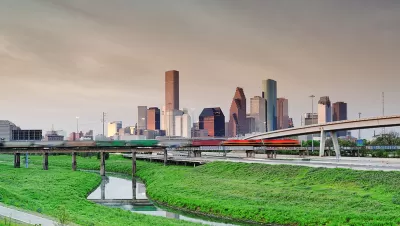History shows that there's more than one way to control flooding, but the best ideas are also urban amenities.

After Hurricane Harvey's destruction, but before money for rebuilding pours in, Jose Solis takes a page in the Houston Chronicle to consider how two cities responded to major floods in the fairly distant past.
"The histories of San Antonio and Los Angeles," Solis writes, "provide strong arguments for why design should play an essential role in developing new infrastructure and a cautionary tale for what happens when it is ignored."
Both Los Angeles and San Antonio experienced major flooding in the 1920s and '30s that brought a great deal of federal funding for major infrastructure to prevent future losses. Los Angeles, using a strategy typical of both the urbanism of the era and of the city itself, buried the Los Angeles River, replacing it with an effective but joyless concrete channel; San Antonio built Riverwalk, which works as a flood control device but also as an amenity for residents and a huge tourist draw.
History has been much kinder to Riverwalk, and Los Angeles is preparing to spend a great deal of money to remake the LA River into something more like it. (Houston's neighbor, New Orleans, also embraced the idea of amenity-as-flood-control after its own catastrophes.)
Solis praises New York City's post-Sandy Rebuild by Design competition as something that "evolved into a broader initiative for rebuilding cities to be more resilient" and suggests that Houston initiate something similar.
"Rebuild by Design," Solis continues, "provides a blueprint for how Houston can attract leading thinkers to develop solutions that will not only protect us during future floods, but let people enjoy living here for all the times between."
FULL STORY: As Houston rebuilds, we need amenities, not eyesores

Planetizen Federal Action Tracker
A weekly monitor of how Trump’s orders and actions are impacting planners and planning in America.

San Francisco's School District Spent $105M To Build Affordable Housing for Teachers — And That's Just the Beginning
SFUSD joins a growing list of school districts using their land holdings to address housing affordability challenges faced by their own employees.

The Tiny, Adorable $7,000 Car Turning Japan Onto EVs
The single seat Mibot charges from a regular plug as quickly as an iPad, and is about half the price of an average EV.

Seattle's Plan for Adopting Driverless Cars
Equity, safety, accessibility and affordability are front of mind as the city prepares for robotaxis and other autonomous vehicles.

As Trump Phases Out FEMA, Is It Time to Flee the Floodplains?
With less federal funding available for disaster relief efforts, the need to relocate at-risk communities is more urgent than ever.

With Protected Lanes, 460% More People Commute by Bike
For those needing more ammo, more data proving what we already knew is here.
Urban Design for Planners 1: Software Tools
This six-course series explores essential urban design concepts using open source software and equips planners with the tools they need to participate fully in the urban design process.
Planning for Universal Design
Learn the tools for implementing Universal Design in planning regulations.
Smith Gee Studio
City of Charlotte
City of Camden Redevelopment Agency
City of Astoria
Transportation Research & Education Center (TREC) at Portland State University
US High Speed Rail Association
City of Camden Redevelopment Agency
Municipality of Princeton (NJ)





























